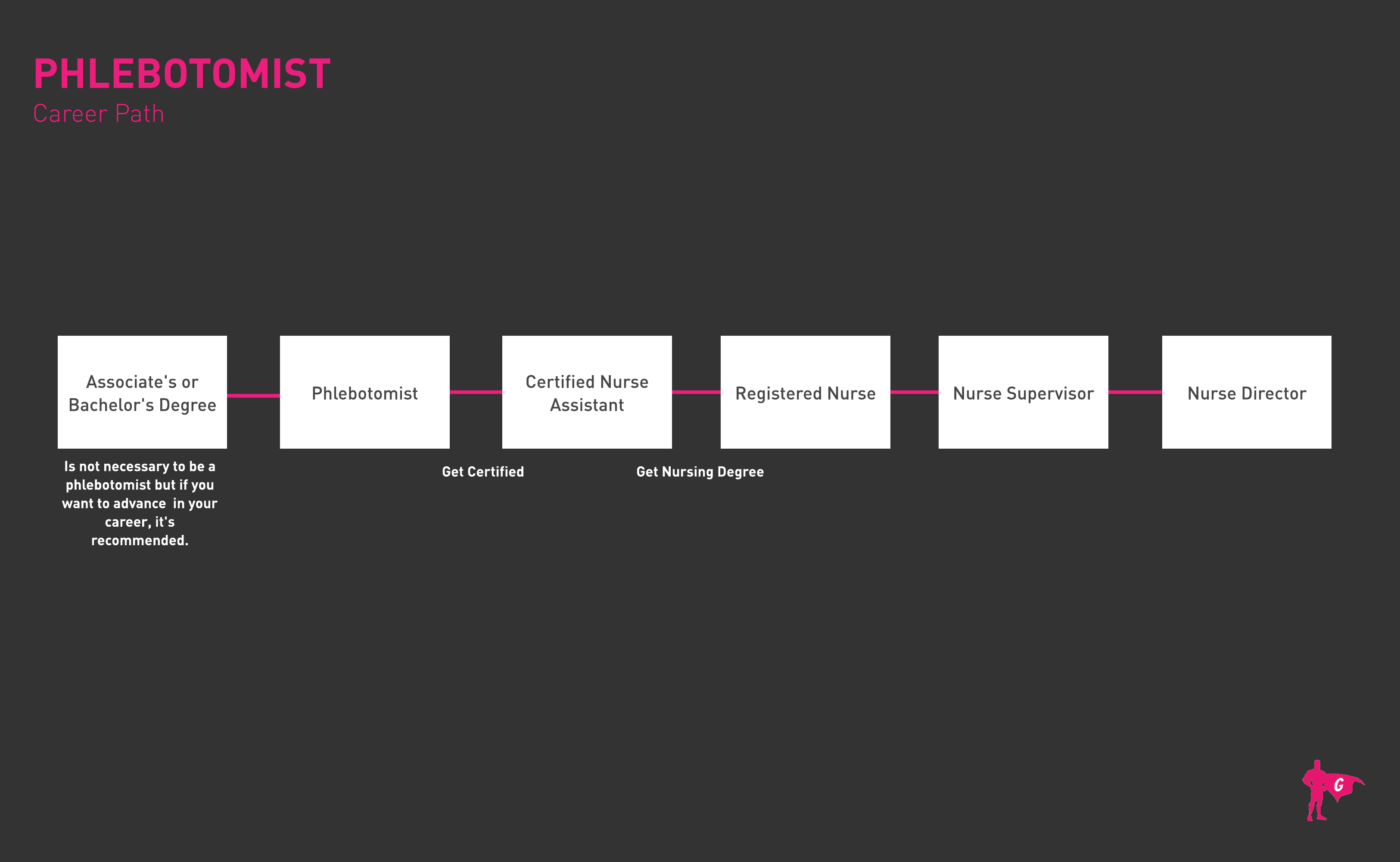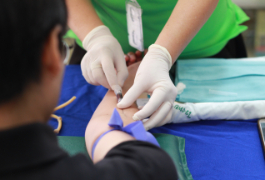Spotlights
Lab Liaison Technician, Mobile Examiner, Patient Service Technician (PST), Phlebotomist, Phlebotomy Technician, Registered Phlebotomist
A Phlebotomist is responsible for drawing blood from patients for transfusions, tests, or donations. They work directly with patients to help them feel comfortable.
- Working directly with patients and helping them stay calm.
- Typically a regular schedule.
- Work is constant, but simple. Results are easy to see.
- Detail oriented.
- Demand for this job is high so you will be easily be able to find work.
A phlebotomist typically works a full-time schedule, with a lot of standing. They handle needles and blood. Depending on the clinic, they may work nights, weekends, and holidays. A phlebotomist spends their day:
- Drawing blood
- Working through the feelings of anxiety a patient may feel.
- Labeling and organizing samples according to type or other terms.
- Use a database to track information.
- Upkeep of workspace, including lab and medical equipment.
- While the information tracked is easy to obtain, they must be detail oriented to make sure samples do not get mixed up.
- Excellent customer service skills.
- Good oral/written communication.
- Able to work with blood and bodily fluid.
- Detail-Oriented
- Computer literate – email, office software.
- Service Oriented
- Critical Thinking
- Clerical skills – filing, transcribing, and filling out forms.
- Hospitals
- Laboratories
- Mobile Health Care Services
- Physician Offices
- Blood banks
Becoming a phlebotomist typically involves a certification. You will need to graduate high school and work through a specialized program. These programs typically take 1 year. The main sacrifice will be paying for textbooks and tuition during the program, as well as working to support yourself.
Another aspect is making sure your own health is up to date – including vaccines. Even with proper safety procedures, you are at risk for blood-borne illness as a phlebotomist.
If you are scared of needles and blood, this is not the career path for you.
Trends in Phlebotomy are tied to the products being used. Improvements are constantly being made to blood collection devices to minimize splatter and maximize safety for both the patient and technician.
Hospital technologies, such as bar codes for patients and increased steps to eliminate mixing up samples, are also ongoing. Database software is constantly being improved, but this will be taught to you in house at your workplace.
- Pretending to be a Doctor or Nurse.
- Helping others – volunteering.
- Soothing friends who are feeling poor.
- Phlebotomists must have a high school diploma (or GED), plus a non-degree certificate from a community college or vocational school Phlebotomy training program
- Phlebotomist programs usually only take a few weeks, for example, 10 weeks of classroom study and 5 weeks of On-the-Job training working in a clinic or doctor’s office
- Class topics will include anatomy, physiology, and medical terminology
- Many states require Phlebotomists to earn a professional certification (which is separate from an academic certificate). Most employers want to hire a professionally-certified worker, whether the state requires it or not
- Per the National Healthcareer Association, “93% of employers require or encourage certification for phlebotomy technicians”
- Students can gain professional Phlebotomy Technician certification through one of the following organizations:
- American Medical Technologists
- American Society for Clinical Pathology
- National Center for Competency Testing
- National Healthcareer Association
- National Phlebotomy Association
- Certification requirements vary but all candidates must pass an exam. The National Center for Competency Testing listed a 72.2% pass rate for test takers in 2021, so it is important to take the test seriously and study hard!
- Students may also be required to pass a criminal background check, drug test, and submit proof of immunizations
- Take college prep classes in high school, including biology, chemistry, math, English, and communications
- If you feel uncomfortable at the sight of blood, you might want to reconsider this career option (or check out this article on how to become comfortable drawing blood on real people!)
- Map your career goals and educational milestones in advance. While the median pay for Phlebotomists is $37,380, a Phlebotomy Supervisor can potentially earn up to twice that!
- Read or watch interviews with Phlebotomists
- Review job ads ahead of time to learn about the qualifications local employers are looking for
- Make sure you understand your state’s specific requirements related to certification. Even if certification is not needed in your state, it can be helpful for landing jobs
- Volunteer with local healthcare-related community organizations
- Stay out of trouble so you can pass the background check when the time comes!

- Due to the high demand for the position, you will likely be able to find a job quickly after earning your certification. Your program will offer opportunities for networking and meeting shareholders who will hire you.
- It is important to consider those in your program as peers who can help you later on. Always stay in positive contact with previous teachers and classmates.
- You should strongly consider getting certified to boost your credentials, even if your state does not require it
- Be honest on your background check questionnaire
- Build strong connections while doing clinical practice. You might later get to work in the clinic or office where you practice, so keep an eye open for job opportunities
- Look for jobs on Indeed, Simply Hired, Glassdoor, or other popular job portals
- If you complete a college or vocational school program, ask your school’s career center for job-seeking tips. See if your program offers job placement assistance
- The states with the highest concentration of jobs for Phlebotomists are West Virginia, Louisiana, New Jersey, Rhode Island, and Alabama. The highest employment levels are in California, Texas, Florida, New York, and Illinois
- Check out Phlebotomists resume templates for ideas on formatting and phrasing
- Review sample Phlebotomists interview questions such as:
- “Tell us about a time you couldn't calm a patient down enough to safely draw blood” or;
- “Tell us about a time a patient fainted. How did you respond?”
- Make sure to conduct a few practice mock interviews and remember to dress for interview success!
- You will likely need additional training to move up from Phlebotomist. However, your certification will give you a good starting point and income if you choose to do so. Many phlebotomists study to become Licensed Practicing Nurses or Registered Nurses. Depending on your performance and employer, you may have financial support for additional school.
- You will need to move up to an Associate’s Degree to move into most other related fields, or to climb the ladder in your organization.
Websites
- American Medical Certification Association
- American Medical Technologists
- American Society for Clinical Pathology
- National Center for Competency Testing
- National Healthcareer Association
- National Phlebotomy Association
Books
- Hartman's Complete Guide for the Phlebotomy Technician, by Hartman Publishing
- NHA Phlebotomy Exam 2021-2022: Study Guide + 300 Questions and Detailed Answer Explanations for the Certified Phlebotomy Technician Examination, by Newstone Phlebotomy Test Prep Team
- Phlebotomy Essentials, Enhanced Edition, by Ruth McCall
You will need additional training or school, but you will likely be able to pivot into:
- Medical Lab Technician
- Medical Assistant
- Intravenous Technician
- Patient Care Technician
Being a phlebotomist is a rewarding entry position for those interested in the health field. It is relatively easy to get started and can provide you with resources to improve your education and find higher paying jobs. If you are interested in nursing or a similar career, it can provide an excellent base knowledge to help you.
Newsfeed

Featured Jobs

Online Courses and Tools

Annual Salary Expectations
New workers start around $46K. Median pay is $51K per year. Highly experienced workers can earn around $58K.







